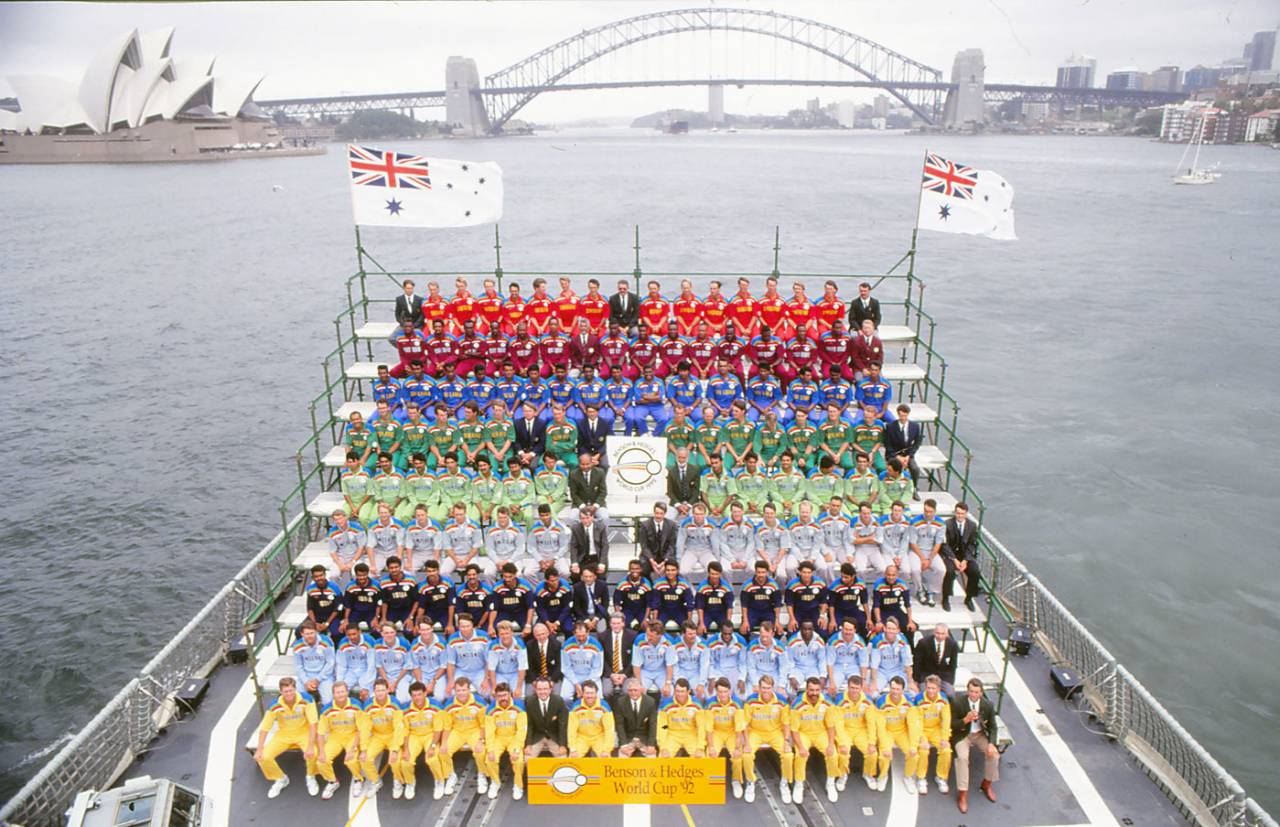Ballarat, Berri, Botham
More than two decades on, the novelty of the 1992 World Cup still lives in the memory
Steven Lynch
23-Mar-2015

Retro means never having to go out of fashion • Getty Images
A funny thing happened as I prepared for my trip to Australia for England's World Cup quarter-final last week: it turned into Bangladesh's quarter-final. And, even after a 24-hour flight, it was difficult to begrudge the delighted Bangladeshi fans, although they were heavily outnumbered by confident Indian ones. Somewhere in the mazy Melbourne laneways there must have been a few displaced Poms, scowling into their beer, but I didn't see any.
The MCG was comfortably full and, traditionalists might grumble, uncomfortably noisy. But it was a thrilling, vibrant atmosphere. Bangladesh didn't help themselves with some creaky fielding later on, and some silly running early in their chase. It all helped the crowd sound more like Mumbai or Mirpur than Melbourne. The absent Englishmen weren't really missed at this subcontinental show.
It was all a far cry from the previous World Cup in Australasia, in 1992, when England were by common consent the strongest team, outdone in the final only by an Imran-inspired Pakistan. That was the first Technicolor World Cup: the first one in coloured clothing - matching shirts that have never yet been surpassed for style (the retro kit is a big seller downtown) - the new-fangled white ball, and floodlights at several of the grounds. No zinger bails, though.
The innovations captured the public imagination more than before - except perhaps in India, where the 1983 upset victory over West Indies had changed cricket forever; failure to reach the semi-finals was now a major disappointment. In England, though, the World Cup had previously been tolerated rather than embraced: amazingly, in 1987, Ian Botham and David Gower both gave the tournament a miss, something almost unimaginable today.
Botham, however, was back as one of the stars of '92. Nearing the end of his career, he finally nagged his captain long enough to be allowed to open the innings, one of the earliest pinch-hitters, and also reserved his best bowling performance for those long-suffering Aussies. And it was Beefy's early dismissal in the final - given out caught behind to a ball he still swears he never touched - that set the alarm bells ringing: Wasim Akram later sealed the deal with a devastating display of reverse swing (another recent arrival).

1992 was the first World Cup to be played under floodlights•Getty Images
I have a feeling that the spectator experience was better back then, too. There was still a newness about the World Cup in 1992. You could rock up to the ground and wander in without being frisked or being suspected of bringing in the wrong brand of cola. And getting a press pass didn't involve 47 emails and an application process that would have tested Bletchley Park - not just because email wasn't common.
The 1992 World Cup, though, was more ambitious in one respect: some of the games were played in remote areas that hadn't seen an international match before (or since): Berri, the South Australian town famous for oranges; Ballarat, in Victoria (famous for being cold, according to my Aussie relatives); Albury, on the New South Wales border, where Zimbabwe upset England; and Mackay, on the north Queensland coast, where the weather permitted only two balls in Sri Lanka's match against India.
Sri Lanka, in fact, clocked up an impressive amount of air miles back then - after a couple of matches in New Zealand they flew up for the two-baller in Mackay, down to Wellington, back across the Tasman to Adelaide, touristed in Ballarat and Berri, and ended up in Perth. They still had enough puff to beat South Africa, though - something the 2015 vintage couldn't manage.
Some of the images of '92 will stay forever fresh in the memory: Martin Crowe's imperious batting (Reverse swing? What reverse swing?), Jonty Rhodes running out Inzamam-ul-Haq, Australia edging India by one run after Steve Waugh dropped a catch but completed a run-out, sunscreen-streaked Allan Donald steaming in, Botham's winsome wiggle after castling yet another Aussie.
And, perhaps most poignant of all, Brian McMillan's long face as South Africa resumed after a short shower in the Sydney semi-final, and the target on the scoreboard changed from "22 off 7 balls" to "22 off 1 ball", thanks to a peculiar rain rule (one of Richie Benaud's poorer ideas, which didn't survive after the tournament). South Africa were undoubtedly unlucky on that stormy Sydney evening, although it's usually forgotten that England were short-changed too - with Graeme Hick going well, South Africa slowed down the over rate, and bowled only 45 in the allotted time. (No penalties then, either in the match or afterwards.) All in all, I bet the South Africans are glad they won't have a Sydney semi this time.
I was there, in the old SCG press box, respectfully silent between a couple of veteran Australian writers. In my mind's eye Bill O'Reilly was in there, but actually I think he had retired by then: maybe everyone just sounded like him. This time technology has taken over, with Wi-Fi and websites uppermost in journalists' minds, rather than the copperplate writing with which O'Reilly carefully composed his columns. But still, despite all the corporateness (and the zinging bails and the pinging emails), it's great to be a part of it.
Steven Lynch is the editor of the Wisden Guide to International Cricket 2014